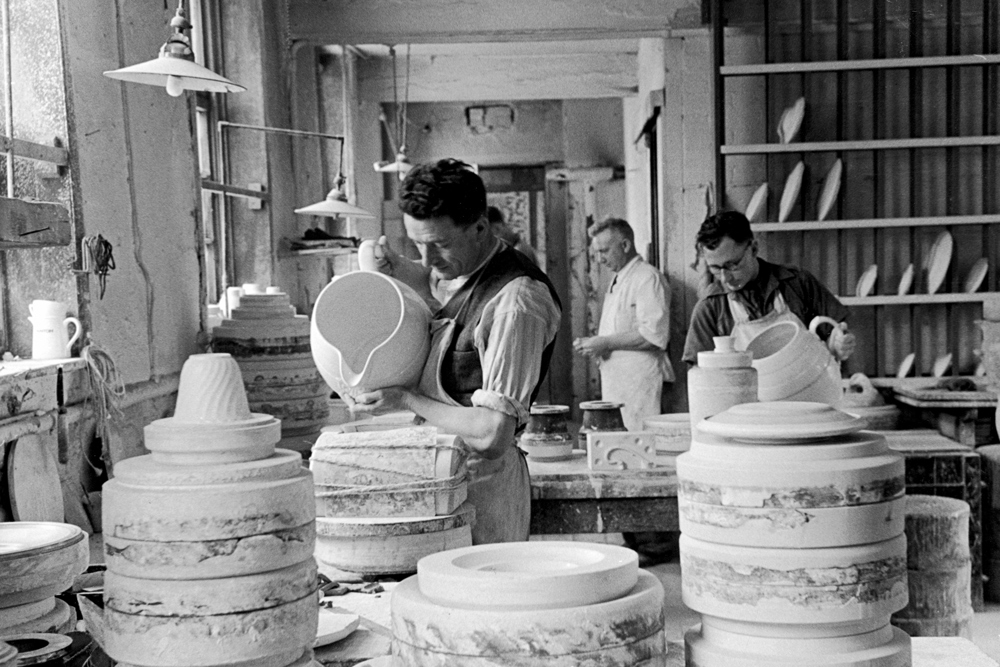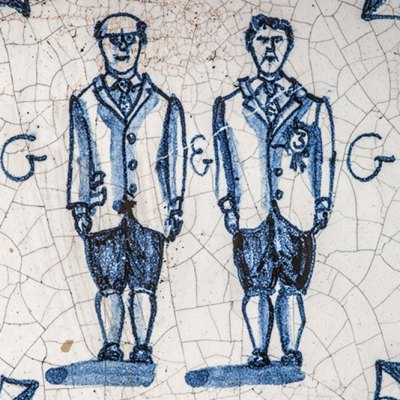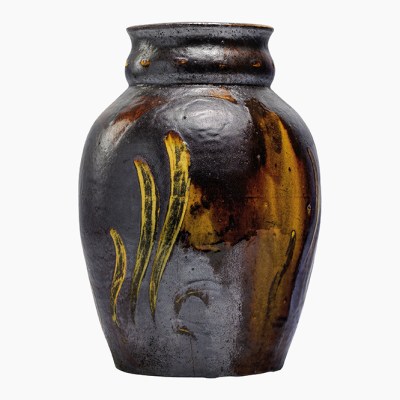Growing up in the 1930s in Tunstall, one of the Six Towns of Stoke-on-Trent, the writer Paul Johnson used to sit at night with his adoring mother watching ‘the volcano landscape’ of the Potteries. ‘Flames and sparks leaping upwards out of the pot-banks […] turning the clouds of smoke orange and pink, sometimes fiery red, the whole angry skyline seeming to heave with the frantic effort to burn and heat and scorch.’ Earlier this month came the sad news that yet another of Stoke’s celebrated potbanks, Royal Stafford, had extinguished its fires for the final time. Based in the Royal Overhouse Manufactory, founded by Thomas Wedgwood in the 1780s, the company had been trading since 1845 and, from 2007, had been producing earthenware under the leadership of the committed local potter Norman Tempest. The firm was a vital part of the Stoke-on-Trent ceramics ecology, making undecorated blanks for numerous other firms including Emma Bridgewater down in Hanley.
An employee at the Emma Bridgewater factory in Stoke-on-Trent, 2015. Photo: Oli Scarff/AFP via Getty Images
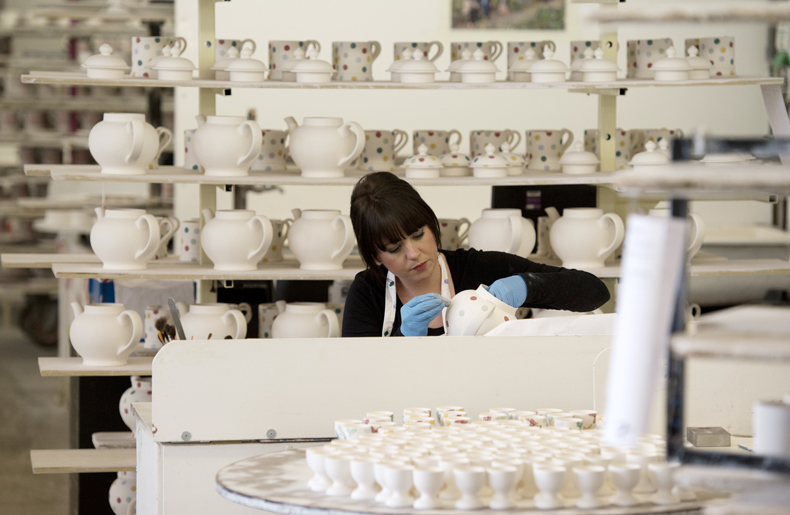
What sunk the business was, according to the directors, ‘a dramatic reduction in orders in recent months coupled with the increase in energy prices’. Eighty-three good jobs have gone, as well as another blow delivered to the cultural fabric of north Staffordshire: potbanks, skilled jobs, design traditions, manufacturing expertise, a rooted sense of identity – so much of this is now at risk of being lost forever. Even the Potters’ Club, a much-loved hub for north Staffordshire sociability and pottery gossip, has recently shuttered its doors.
The Potteries – an elemental part of British culture since the mid 18th century – are facing an existential crisis. This ‘rugged, pott-making spot of earth’, as Wedgwood called it, inspired the cityscapes of Maurice Wade; the novels of Arnold Bennett; and, of course, the sumptuous designs of Wedgwood, Josiah Spode, Herbert Minton, Clarice Cliff, Eric Ravilious and Edward Bawden. In one depressing sense, this is the continuation of a trend. In 1984 there were 66 major potteries in Staffordshire employing around 30,000 workers; by 2011, in the face of steady globalisation and the entry of China and East Asia into world markets, those numbers had fallen to 33 pottery firms employing some 8,000 people. Today, according to the British Ceramics Confederation, there are probably 5,000 employed in ceramics across Stoke-on-Trent.
Queen Elizabeth II coronation mug by Eric Ravilious, manufactured by Josiah Wedgwood and Sons, Ltd., designed in 1936 and adapted 1953. Photo: Indianapolis Museum of Art/Getty Images
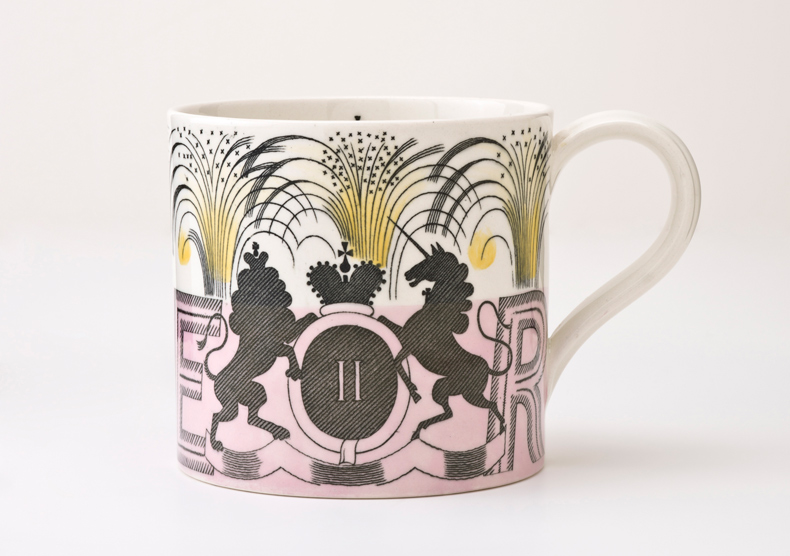
Yet the loss of Royal Stafford feels particularly painful as it removes yet another cultural and economic pillar from Burslem, the ‘mother town’ of the Potteries, elegiacally described by Arnold Bennett as ‘nestled in the hollow between several hills, and showing a vague picturesque mass of bricks through its heavy pall of smoke’. He thought it ‘not beautiful in detail, but the smoke transforms its ugliness into a beauty transcending the work of architects and of time’.
Today, such a description would be generous as the High Street copes with boarded-up shops and businesses. Combine that with an empty Wedgwood Institute (opened by William Gladstone no less) and the cannabis-farm-induced arson of the great Leopard Inn where Josiah Wedgwood and James Brindley inaugurated the Trent & Mersey Canal, and the situation is becoming bleak.
The derelict former Price and Kensington pottery and kiln in Burslem, Stoke-on-Trent, in 2024. Photo: Christopher Furlong/Getty Images
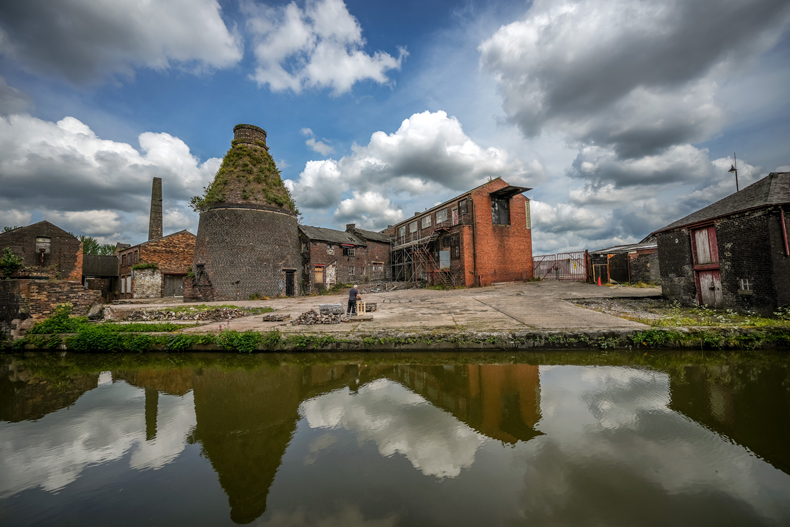
So, what is to be done? First of all celebrate the successes. Well-run companies investing in design, such as Portmeirion, Churchill, Steelite, Wedgwood, Duchess, Bridgewater and others, continue to produce globally competitive ceramics from Stoke-on-Trent. Meanwhile, the work of Middleport Pottery, the V&A Wedgwood Collection, the Spode Site, the Potteries Museum and Art Gallery are all passionately displaying Stoke’s design and craft heritage. Then, address the crippling challenges facing our pottery businesses. Not much can reshape the shifts in consumer habits: the end of wedding lists replete with china and crystal; the rise of a takeaway culture and collapsing tableware markets; a cost-of-living crisis that prioritises cheap imports. But we should do something about the UK’s energy costs. For pottery manufacturers in Stoke-on-Trent, the price of energy is 28 pence per kwh; in France it is 9p; in Spain 8p; and in the United States it is 7p. If we want to hold on to our energy-intensive sector – and the cultural identity, civic pride and regional economies they sustain – we need to grapple with this inherent inequity.
Wedgwood pottery worker Frances Pitt in 1952 carrying a tray of Wedgwood Blue teapots, each adorned with the head of Elizabeth II, as they head for the firing kilns ahead of the Coronation. Photo: Reg Speller/Fox Photos/Hulton Archive/Getty Images
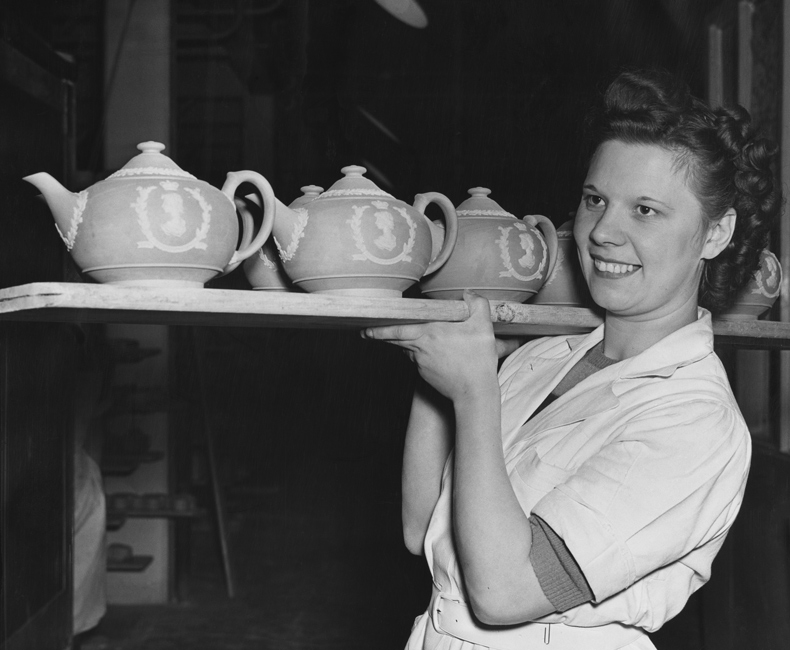
We can also lobby for a proper system of labelling to ensure that pottery made abroad – even if then decorated in the UK – is declared as imported goods. There is pretty much zero gain to leaving the European Union, but we do now have the freedom to introduce a proper back-stamping system so that only pottery thrown and fired in the UK can be described as ‘Made in England’.
A pottery worker decorates official chinaware produced for the Coronation of King Charles III at a factory in Stoke-on-Trent, 2023. Photo: Frank Augstein / POOL / AFP via Getty Images
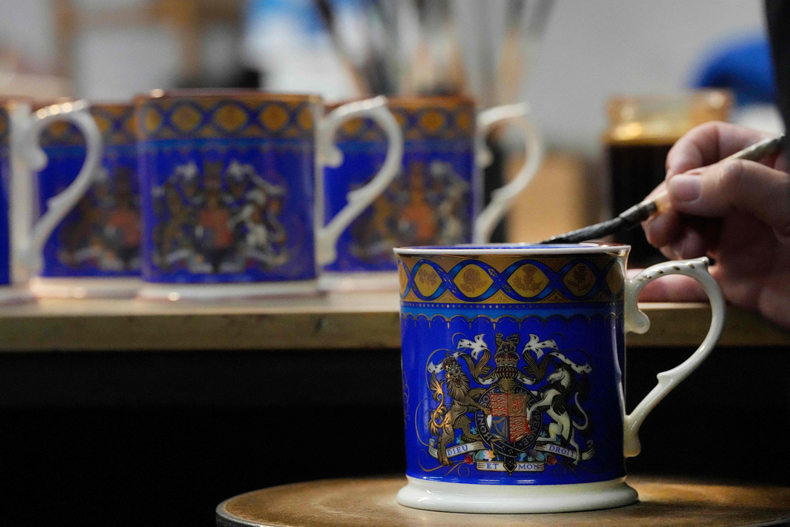
At the same time as Paul Johnson was watching the potbank flames and sparks, J.B. Priestley was passing through north Staffordshire on his ‘English Journey’. After a few days trying his hand at throwing and decorating, he concluded that the bottle kilns ‘represent the very heat and soul of the district’. The end of Royal Stafford only intensifies the need to keep that heat and soul alive.
Tristram Hunt is director of the Victoria and Albert Museum and author of The Radical Potter: The Life and Times of Josiah Wedgwood (Penguin).
